The Intel Core i7-7700K (91W) Review: The New Out-of-the-box Performance Champion
by Ian Cutress on January 3, 2017 12:02 PM ESTProfessional Performance: Windows
Agisoft Photoscan – 2D to 3D Image Manipulation: link
Agisoft Photoscan creates 3D models from 2D images, a process which is very computationally expensive. The algorithm is split into four distinct phases, and different phases of the model reconstruction require either fast memory, fast IPC, more cores, or even OpenCL compute devices to hand. Agisoft supplied us with a special version of the software to script the process, where we take 50 images of a stately home and convert it into a medium quality model. This benchmark typically takes around 15-20 minutes on a high end PC on the CPU alone, with GPUs reducing the time.
Here we report the overall time to complete the test – sub-test results can be found in Bench.
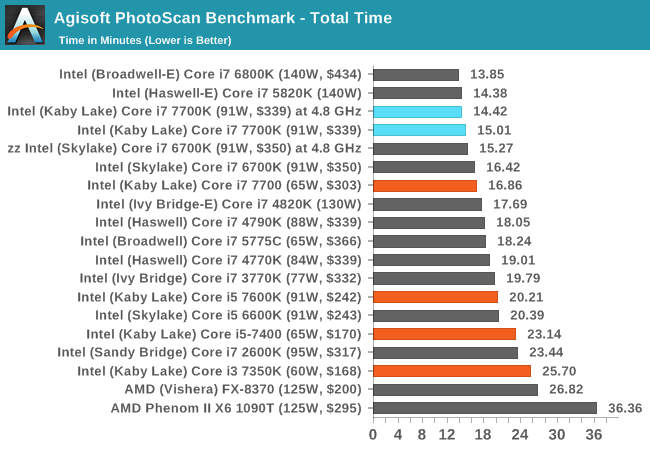
Here’s another instance where a stock Core i7-7700K can overcome an overclocked Devil’s Canyon. Agisoft spends a good time of its workload using cache heavy threads, showing that large core parts do really well, however the i7-7700K is on par with the six-core Core i7-3960X, showing that extra IPC and frequency can make up for a core or two.
Cinebench R15
Cinebench is a benchmark based around Cinema 4D, and is fairly well known among enthusiasts for stressing the CPU for a provided workload. Results are given as a score, where higher is better.
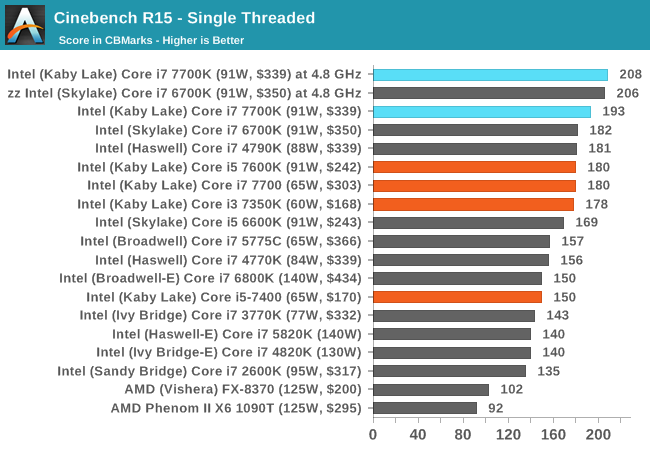
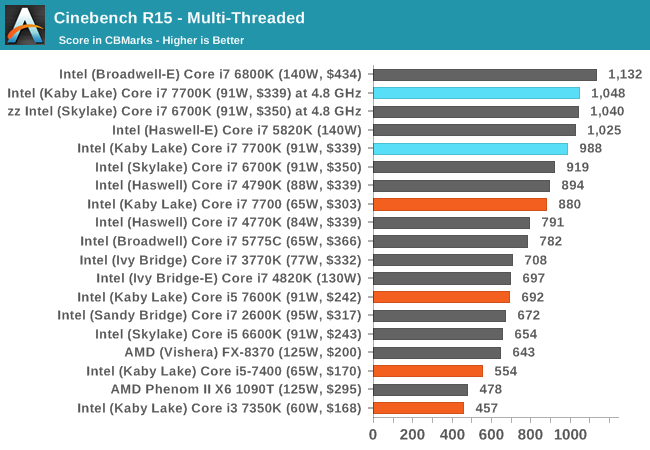
While Cinebench R15 is more a synthetic, it remains a popular test to measure professional performance and is free to use. For single threaded performance, the Core i7-7700K hits the top of the pile. With the Skylake and Kaby Lake parts both at 4.8 GHz, there’s almost nothing between them, showing the identical IPC. In multithreaded mode the 7700K is on top of all the mainstream processors as expected, and when overclocked can mix it up with some of the extreme processors as well.
HandBrake v0.9.9: link
For HandBrake, we take two videos (a 2h20 640x266 DVD rip and a 10min double UHD 3840x4320 animation short) and convert them to x264 format in an MP4 container. Results are given in terms of the frames per second processed, and HandBrake uses as many threads as possible.

The LQ video emphasizes IPC due to its low cache overhead, meaning that the i7-7700K wins again, and when overclocked, performs the same as the 6700K at the same frequency.
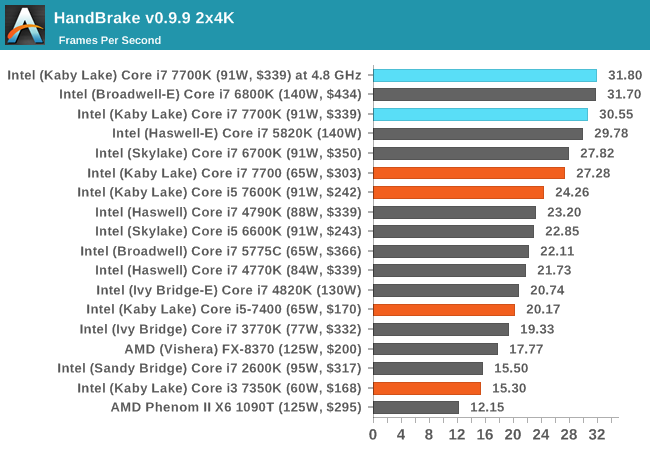
The higher resolution video however means that cores with frequency dominate. The i7-7700K stands above processors such as the i7-5820K, the i7-4930K and the i7-3960X, which is no small feat. But if you really want performance here, the big boys are still top performers (if you can afford them).
Hybrid x265
Hybrid is a new benchmark, where we take a 4K 1500 frame video and convert it into an x265 format without audio. Results are given in frames per second.
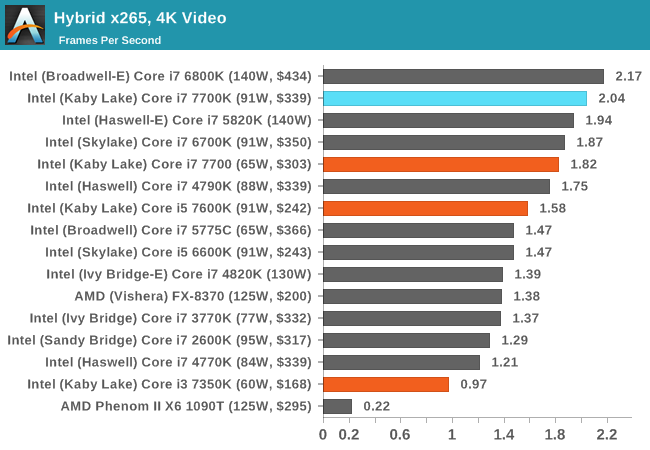
Our Hybrid test is somewhat similar to the HandBrake HQ test, showing the i7-7700K sitting tall as the mainstream champion.










125 Comments
View All Comments
Michael Bay - Saturday, January 14, 2017 - link
Doom is not very CPU-intensive, and Battlefield is just drek.cpy - Wednesday, January 4, 2017 - link
OMG AVX offset? What took them so long! I need AVX offset for my 4770K! That thing really mess with my OC. It feels like everytime AVX is used i need +0.1V to CPU.thekdub - Wednesday, January 4, 2017 - link
Why is the 4790K "highly overclocked" in these benchmarks, while everything else appears to be running at stock speeds? I was hoping to get some insight as to where my stock 4790K stacks against this new chip as I'm on the fence about upgrading this year or waiting another generation. Instead, I'm stuck making inferences and trying to guess the difference in speed between a known variable and a vague statement of "highly overclocked".Achaios - Wednesday, January 4, 2017 - link
@OP: It is a mistake that you did not explicitly state the OC of the chips you compared.The only thing I am interested right now is the release pf the 1080TI, so please ANANDTECH do your best to bring us some news (preview) regarding.
CPU releases are completely uninteresting and by-and-large meaningless to anyone on a K Sandy Bridge CPU.
I am on a Haswell, and don't see myself upgrading before 2020. Conversely, up to 2020, I would have upgraded my GPU twice.
Achaios - Wednesday, January 4, 2017 - link
"by-and-large meaningless to anyone on a K Sandy Bridge CPU OR LATER". Please consider adding an EDIT function too. :-)just4U - Wednesday, January 4, 2017 - link
Yeah.. there isn't really much of a jump is there? Buying a 7700K for people already on High End I7's made in the past few years is more about ... just wanting something newer, with maybe taking advantage of what some of the newest MBs offer.. I think anyway. Speed? Pfft... you already got that..Now if they released a mainstream I7 that had 6 cores/12 threads in the same package, well then.. that might be something of a different story. (..shrug) intels loss.
Badelhas - Wednesday, January 4, 2017 - link
"Given that Intel has no competition, it is perhaps easy to roll out a new mainstream performance champion".This frase sums it up. And this is why I still own a SandyBridge i5 2500K overclocked to 4.4Ghz (a 33% increase) and find no need to upgrade. Intel is not even trying. It´s just SAD.
Thatguy97 - Wednesday, January 4, 2017 - link
When ivy bridge came out I saw this comingwillis936 - Wednesday, January 4, 2017 - link
Wow I can't believe it: an entire generation of CPUs that change absolutely nothing about the microarchitecture design or transistor size. Why even bother rolling out new SKUs?willis936 - Wednesday, January 4, 2017 - link
This would have been the perfect generation to add eDRAM to the K series. If only AMD would put out.